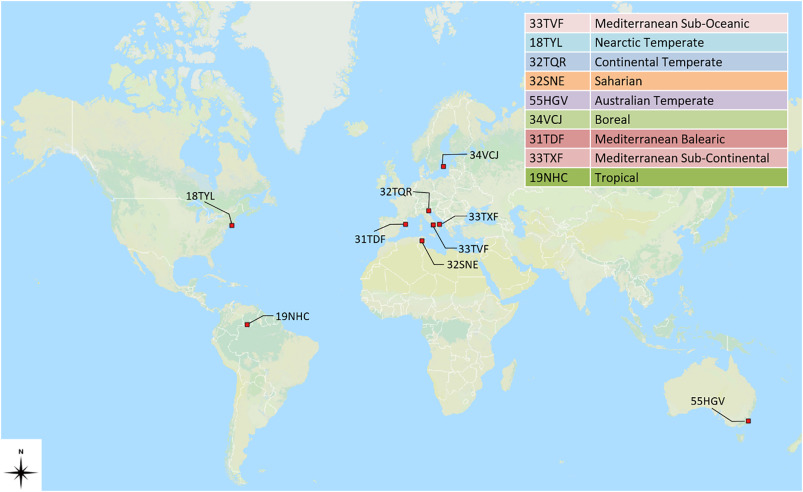当前位置:
X-MOL 学术
›
Remote Sens. Environ.
›
论文详情
Our official English website, www.x-mol.net, welcomes your
feedback! (Note: you will need to create a separate account there.)
A first assessment of the Sentinel-2 Level 1-C cloud mask product to support informed surface analyses
Remote Sensing of Environment ( IF 11.1 ) Pub Date : 2018-11-01 , DOI: 10.1016/j.rse.2018.08.009 Rosa Coluzzi , Vito Imbrenda , Maria Lanfredi , Tiziana Simoniello
Remote Sensing of Environment ( IF 11.1 ) Pub Date : 2018-11-01 , DOI: 10.1016/j.rse.2018.08.009 Rosa Coluzzi , Vito Imbrenda , Maria Lanfredi , Tiziana Simoniello

|
Abstract Cloud detection in optical remote sensing images is a crucial problem because undetected clouds can produce misleading results in the analyses of surface and atmospheric parameters. Sentinel-2 provides high spatial resolution satellite data distributed with associated cloud masks. In this paper, we evaluate the ability of Sentinel-2 Level-1C cloud mask products to discriminate clouds over a variety of biogeographic scenarios and in different cloudiness conditions. Reference cloud masks for the identification of misdetection were generated by applying a local thresholding method that analyses Sentinel-2 Band 2 (0.490 μm) and Band 10 (1.375 μm) separately; histogram-based thresholds were locally tuned by checking the single bands and the natural color composite (B4B3B2); in doubtful cases, NDVI and DEM were also analyzed to refine the masks; the B2B11B12 composite was used to separate snow. The analysis of the cloud classification errors obtained for our test sites allowed us to get important inferences of general value. The L1C cloud mask generally underestimated the presence of clouds (average Omission Error, OE, 37.4%); this error increased (OE > 50%) for imagery containing opaque clouds with a large transitional zone (between the cloud core and clear areas) and cirrus clouds, fragmentation emerged as a major source of omission errors (R2 0.73). Overestimation was prevalently found in the presence of holes inside the main cloud bodies. Two extreme environments were particularly critical for the L1C cloud mask product. Detection over Amazonian rainforests was highly inefficient (OE > 70%) due to the presence of complex cloudiness and high water vapor content. On the other hand, Alpine orography under dry atmosphere created false cirrus clouds. Altogether, cirrus detection was the most inefficient. According to our results, Sentinel-2 L1C users should take some simple precautions while waiting for ESA improved cloud detection products.
中文翻译:

对 Sentinel-2 1-C 级云罩产品的首次评估,以支持明智的表面分析
摘要 光学遥感图像中的云检测是一个至关重要的问题,因为未检测到的云会在地表和大气参数分析中产生误导性结果。Sentinel-2 提供高空间分辨率的卫星数据,分布与相关的云掩膜。在本文中,我们评估了 Sentinel-2 Level-1C 云罩产品在各种生物地理场景和不同云量条件下区分云的能力。用于识别误检测的参考云掩模是通过应用局部阈值方法生成的,该方法分别分析 Sentinel-2 Band 2 (0.490 μm) 和 Band 10 (1.375 μm);通过检查单波段和自然色合成 (B4B3B2),对基于直方图的阈值进行了局部调整;在有疑问的情况下,还分析了 NDVI 和 DEM 以细化掩码;B2B11B12 复合材料用于分离雪。对我们测试站点获得的云分类错误的分析使我们能够获得具有普遍价值的重要推论。L1C 云掩膜普遍低估了云的存在(平均遗漏误差,OE,37.4%);对于包含具有大过渡区(在云核心和清晰区域之间)和卷云的不透明云的图像,该误差增加(OE > 50%),碎片成为遗漏误差的主要来源(R2 0.73)。在主要云体内部存在孔洞的情况下普遍发现高估。两个极端环境对 L1C 云遮罩产品尤为关键。由于存在复杂的云雾和高水蒸气含量,亚马逊雨林的检测效率非常低(OE > 70%)。另一方面,干燥大气下的高山地形产生了假卷云。总而言之,卷云检测效率最低。根据我们的结果,Sentinel-2 L1C 用户在等待 ESA 改进的云检测产品时应该采取一些简单的预防措施。
更新日期:2018-11-01
中文翻译:

对 Sentinel-2 1-C 级云罩产品的首次评估,以支持明智的表面分析
摘要 光学遥感图像中的云检测是一个至关重要的问题,因为未检测到的云会在地表和大气参数分析中产生误导性结果。Sentinel-2 提供高空间分辨率的卫星数据,分布与相关的云掩膜。在本文中,我们评估了 Sentinel-2 Level-1C 云罩产品在各种生物地理场景和不同云量条件下区分云的能力。用于识别误检测的参考云掩模是通过应用局部阈值方法生成的,该方法分别分析 Sentinel-2 Band 2 (0.490 μm) 和 Band 10 (1.375 μm);通过检查单波段和自然色合成 (B4B3B2),对基于直方图的阈值进行了局部调整;在有疑问的情况下,还分析了 NDVI 和 DEM 以细化掩码;B2B11B12 复合材料用于分离雪。对我们测试站点获得的云分类错误的分析使我们能够获得具有普遍价值的重要推论。L1C 云掩膜普遍低估了云的存在(平均遗漏误差,OE,37.4%);对于包含具有大过渡区(在云核心和清晰区域之间)和卷云的不透明云的图像,该误差增加(OE > 50%),碎片成为遗漏误差的主要来源(R2 0.73)。在主要云体内部存在孔洞的情况下普遍发现高估。两个极端环境对 L1C 云遮罩产品尤为关键。由于存在复杂的云雾和高水蒸气含量,亚马逊雨林的检测效率非常低(OE > 70%)。另一方面,干燥大气下的高山地形产生了假卷云。总而言之,卷云检测效率最低。根据我们的结果,Sentinel-2 L1C 用户在等待 ESA 改进的云检测产品时应该采取一些简单的预防措施。











































 京公网安备 11010802027423号
京公网安备 11010802027423号